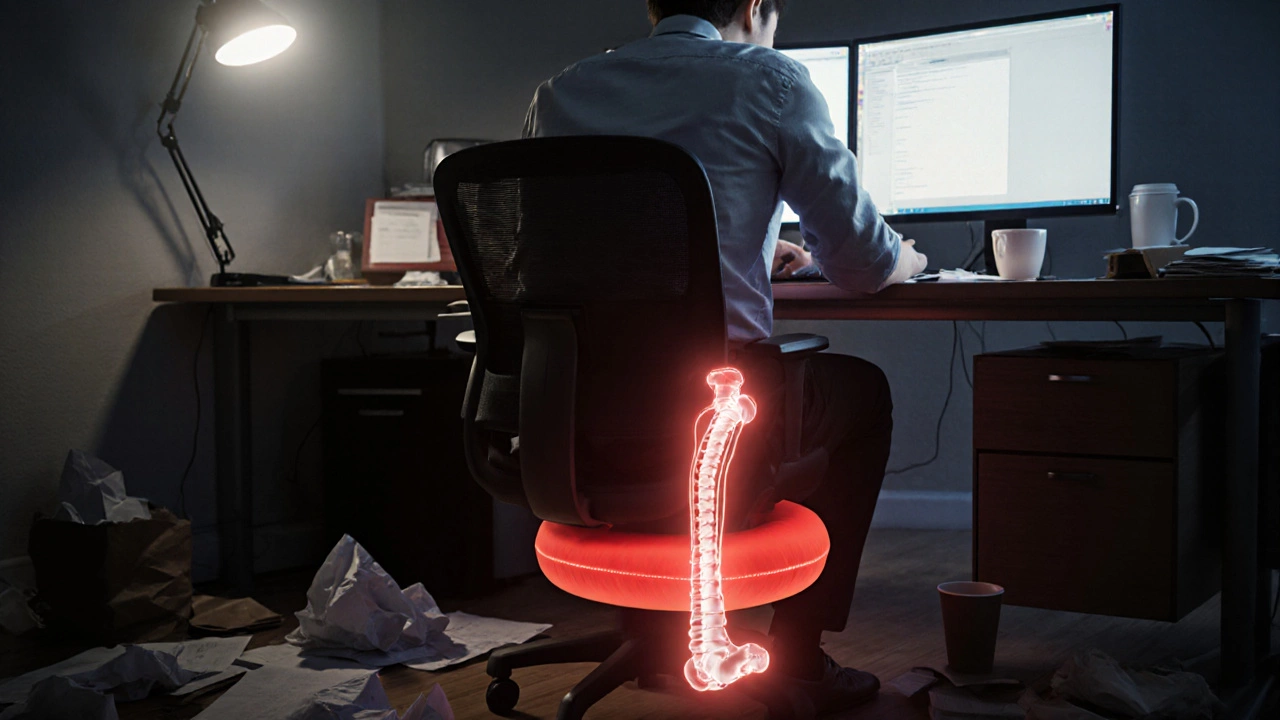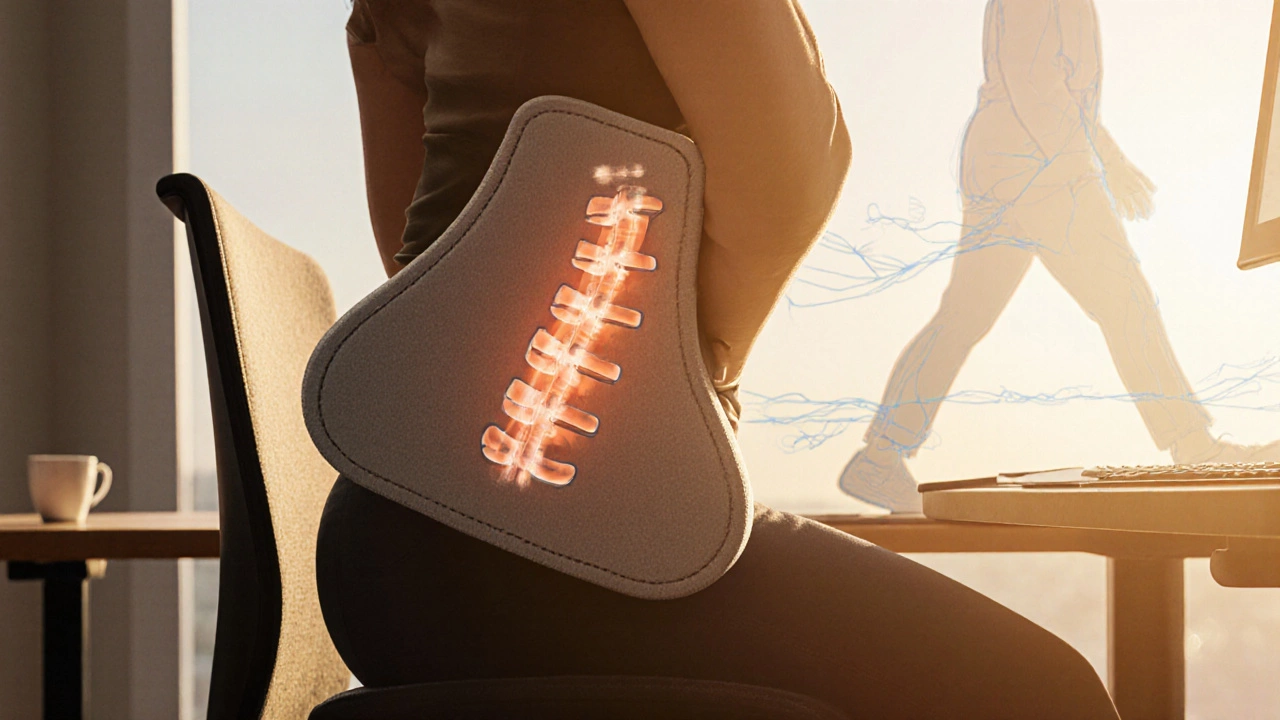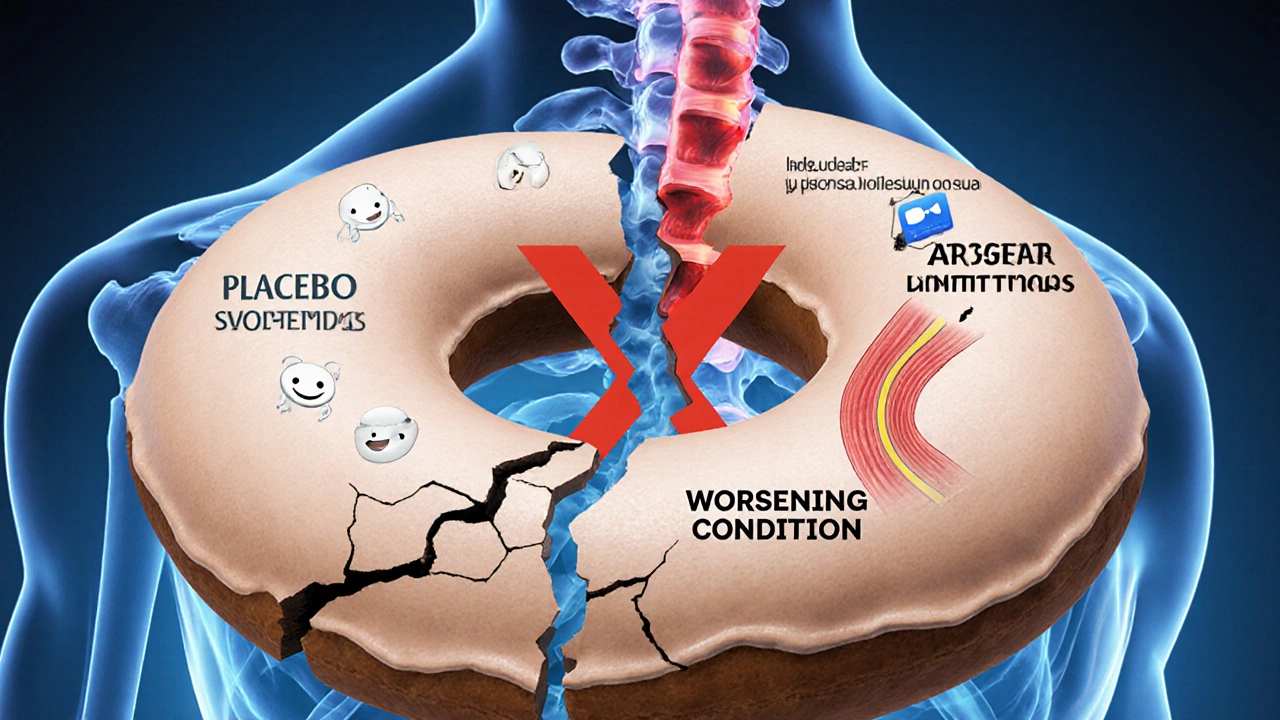
Sciatica Pain Assessment Tool
This tool helps you determine if donut cushions will help your sciatica pain. Based on the article content, donut cushions are designed for tailbone pain but often don't help sciatica. Select your primary pain location:
If you’ve been dealing with sciatica pain, you’ve probably heard about the donut cushion. You know the one - the ring-shaped pillow that looks like a life ring for your butt. It’s sold everywhere: online, at drugstores, even in some chiropractor’s waiting rooms. The promise? Relief from sciatica pain just by sitting on it. But does it actually work? Or is it just another wellness trend with a cute name?
What sciatica really feels like
Sciatica isn’t a diagnosis - it’s a symptom. It’s the sharp, burning, or electric pain that shoots from your lower back down one leg, sometimes all the way to your foot. It’s not just discomfort. It can make sitting, standing, or walking unbearable. People describe it as a knife stabbing through their leg, or like their nerve is being squeezed by a vise. It often comes from a herniated disc, spinal stenosis, or tight piriformis muscle pinching the sciatic nerve.
When you sit, your body weight presses on your tailbone and sacrum. If your spine isn’t aligned, or if your pelvis is tilted, that pressure can make the nerve flare up. That’s why sitting for long periods - at a desk, in a car, or on the couch - often makes sciatica worse.
How donut cushions are supposed to work
The idea behind the donut cushion is simple: take pressure off your tailbone. The hole in the middle is meant to cradle your sit bones (ischial tuberosities) while leaving the area around your tailbone empty. The theory is that by avoiding direct pressure on the coccyx, you reduce irritation to the sciatic nerve nearby.
Some donut cushions are made of memory foam, others of gel or air. Some have non-slip bottoms, others come with straps to hold them in place on chairs. They’re marketed as a quick fix - no pills, no injections, no surgery. Just sit on it and feel better.
But here’s the problem: the sciatic nerve doesn’t run under your tailbone. It runs deeper, behind your hip bones, near the piriformis muscle. If your pain is coming from a disc issue or nerve compression in your lower spine, taking pressure off your tailbone won’t fix that.
What the research says
There’s no solid clinical study proving donut cushions relieve sciatica. A 2022 review in the Journal of Orthopaedic & Sports Physical Therapy looked at 17 different cushion types used for low back and nerve pain. Only two showed mild short-term relief - and neither was the traditional donut shape. The authors concluded that most cushion designs lack evidence-based support for nerve-related pain.
Even the American Academy of Orthopaedic Surgeons doesn’t recommend donut cushions for sciatica. They’re sometimes used for post-surgical tailbone injuries (like after a hemorrhoidectomy), but not for nerve compression.
What does help? Movement. Stretching. Proper posture. Core strengthening. Physical therapy. These are backed by decades of research. Donut cushions? Not so much.

Why people think they work
Let’s be real - some people swear by their donut cushion. They say, “It helped me sit through my Zoom meetings.” Or, “I didn’t feel that stabbing pain anymore.” So why?
It’s likely placebo, or a side effect of changing how they sit. When someone buys a donut cushion, they often sit up straighter. They adjust their chair. They take breaks more often. They might even start doing hip stretches because they’re paying more attention to their body. The cushion isn’t doing the work - their behavior change is.
Also, donut cushions can reduce pressure on hemorrhoids or skin sores. If someone has both sciatica and tailbone soreness, they might feel better overall - and wrongly credit the cushion for nerve relief.
What actually helps sciatica when sitting
If you’re sitting for long hours and your sciatica flares up, here’s what science says works:
- Use a lumbar roll or small pillow behind your lower back. This keeps your spine in a neutral position, reducing pressure on discs and nerves.
- Keep your hips slightly higher than your knees. Sit on a wedge cushion or stack a book under your chair legs. This opens up your pelvis and takes strain off the sciatic nerve.
- Get up every 20-30 minutes. Walk for 1-2 minutes. Stretch your hamstrings. Do a gentle pelvic tilt. Movement is the best medicine.
- Avoid slouching or crossing your legs. Both positions twist the pelvis and compress the nerve.
- Try a contoured seat cushion. Not a donut - one that supports your sit bones and curves to match your spine. Brands like ComfiLife or Everlasting Comfort have models designed for sciatica, with memory foam and a slight forward tilt.
One 2023 study in the Spine Journal followed 120 people with chronic sciatica who used ergonomic seating for 6 weeks. Those who used lumbar-supported, tilted cushions reported a 40% reduction in pain. Those using donut cushions? No significant change.
The hidden dangers of donut cushions
There’s another reason to be careful. Donut cushions can make sciatica worse over time.
Because the cushion leaves your tailbone unsupported, your pelvis may tilt backward. This flattens your natural lumbar curve. That puts more pressure on your lower discs - exactly where sciatica often starts.
Some users report increased numbness or tingling after using donut cushions for weeks. That’s because the cushion forces your body into an unnatural position. Your hips rotate. Your glutes tighten. Your piriformis muscle gets tighter - and the sciatic nerve gets squeezed even more.
It’s like trying to fix a crooked picture frame by pushing on the wrong corner. You might think it looks better, but you’re just making the problem worse.

What to buy instead
If you’re shopping for a cushion to help with sciatica, skip the donut. Look for these features:
- Contoured shape - follows the curve of your lower back and hips
- Memory foam or gel - molds to your body, doesn’t flatten out
- Forward tilt - encourages pelvis to stay neutral
- Lumbar support built-in - or comes with a separate pillow
- Non-slip base - stays in place on chairs
Two affordable, well-reviewed options: the ComfiLife Gel-Infused Memory Foam Seat Cushion and the Everlasting Comfort Lumbar Support Pillow. Both are used by physical therapists in Toronto clinics and have helped patients reduce pain without drugs.
When to see a professional
If your sciatica lasts more than two weeks, gets worse, or causes weakness in your leg or foot, see a doctor or physical therapist. You might need imaging, nerve blocks, or targeted exercises.
Don’t rely on a cushion to fix something that needs real treatment. Sciatica can be managed - but not with a ring of foam.
Final verdict
Sitting on a donut cushion won’t help your sciatica. It might feel better for a few minutes because you’re changing your posture - but it doesn’t address the root cause. In fact, it might make things worse over time.
Real relief comes from supporting your spine, moving often, and strengthening your core. A well-designed ergonomic cushion can help - but only if it’s shaped right. Skip the donut. Choose support over holes.
Can a donut cushion make sciatica worse?
Yes. Donut cushions can cause your pelvis to tilt backward, flattening your lower back curve. This increases pressure on your spinal discs and tightens the piriformis muscle, which can pinch the sciatic nerve even more. Many users report increased numbness or tingling after prolonged use.
What’s the best cushion for sciatica pain?
Look for a contoured memory foam cushion with built-in lumbar support and a slight forward tilt. These help keep your spine aligned and take pressure off the sciatic nerve. Popular choices include the ComfiLife Gel-Infused Seat Cushion and the Everlasting Comfort Lumbar Pillow - both recommended by physical therapists.
How long should I sit with sciatica?
No more than 20-30 minutes at a time. Get up, walk for 1-2 minutes, stretch your hamstrings, and do a gentle pelvic tilt. Movement reduces nerve irritation better than any cushion. Sitting for hours, even with a cushion, increases inflammation and stiffness.
Are donut cushions good for tailbone pain?
They can help with coccyx pain from injuries or surgery, like after a hemorrhoidectomy. But they’re not designed for nerve-related pain like sciatica. If your tailbone hurts but your leg doesn’t, a donut might offer relief. If your leg is burning or numb, you need something else.
Can I use a donut cushion on my car seat?
It’s not recommended. Car seats are already designed with specific contours. Adding a donut cushion can throw off your posture, make it harder to reach pedals, and reduce safety in a crash. For driving, use a lumbar roll and take breaks every 30 minutes instead.




